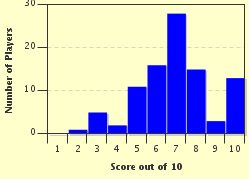Quiz Answer Key and Fun Facts
1. This dark nebula's more common name is derived from what some people say they see as they look at the swirling cloud of gases and dust that appears to rear up. What is the common name of this nebula?
2. This bipolar planetary nebula's more common name is derived from what most people claim to see as they look at it from Earth. What is its common name?
3. This nebula is located in the center of our Milky Way galaxy and can be seen when looking into the northwest corner of the constellation Sagittarius. What is this nebula's common name, derived from what viewers claim to see?
4. The image seen here is part of the Carina Nebula, which is so large it allows viewers to interpret smaller images within it. What is the common name of the image seen here?
5. The intricate pattern of this planetary nebula, as seen from the earth, has reminded many viewers of a toy some children have played with since the 1960s. What is the common name of this nebula?
6. Some refer to the inner spot of this planetary nebula as the "eye of God" (a phrase more often used with the Helix Nebula). Nevertheless, what is the common name of the entire nebula, according to what some say they see?
7. The clouds seen here are part of a much larger region of ionized gas and are in the process of making new stars. What do you think others call this image as they look upon it?
8. One can view this phenomenon while looking toward the constellation Taurus, not Cancer as this nebula's common name might suggest. What is its common name?
9. To determine the common name of the famous nebula in the photograph, a viewer should look at the image the way others have. The animal that others believe they see is facing to the right with its back to the left. What is the common name of this nebula?
10. This planetary nebula, also known as NGC 6720, can be seen in the direction of the northern constellation Lyra. What is the common name of this nebula, based on what others say they see as they gaze upon it from Earth?
Source: Author
alaspooryoric
This quiz was reviewed by FunTrivia editor
NatalieW before going online.
Any errors found in FunTrivia content are routinely corrected through our feedback system.

